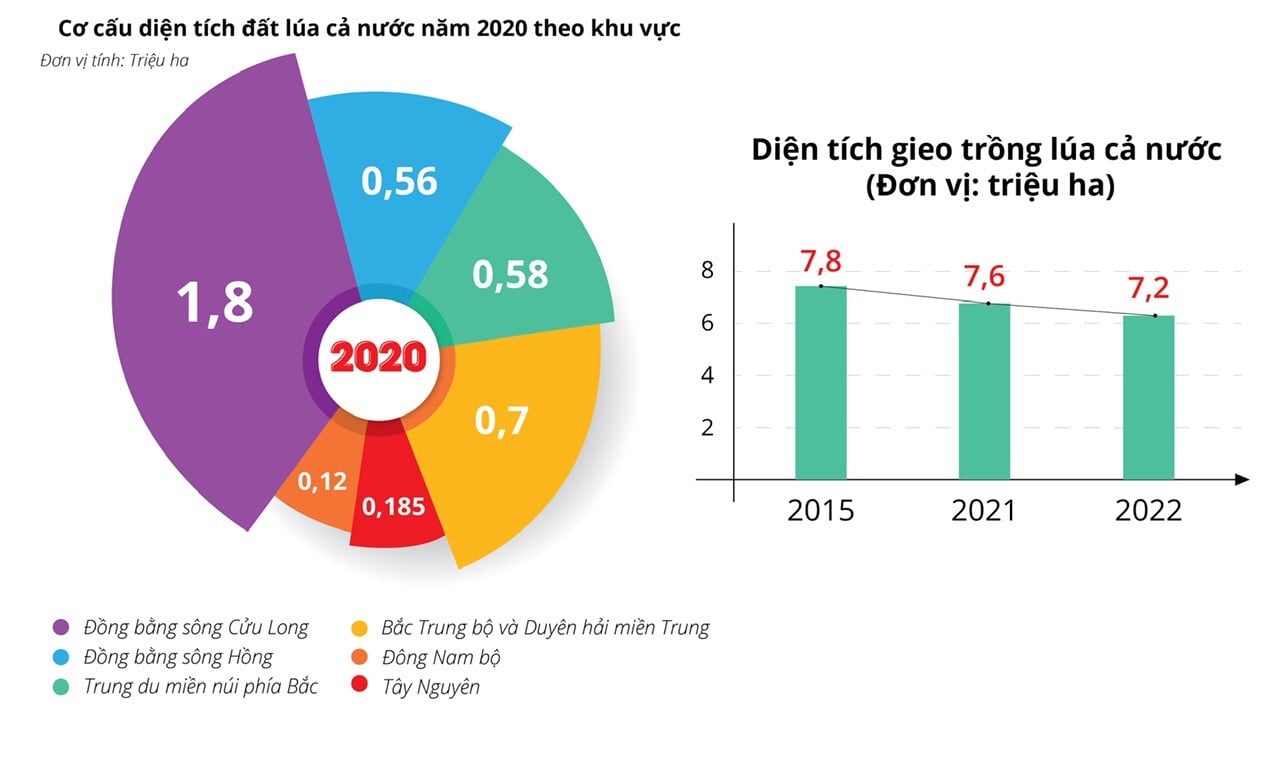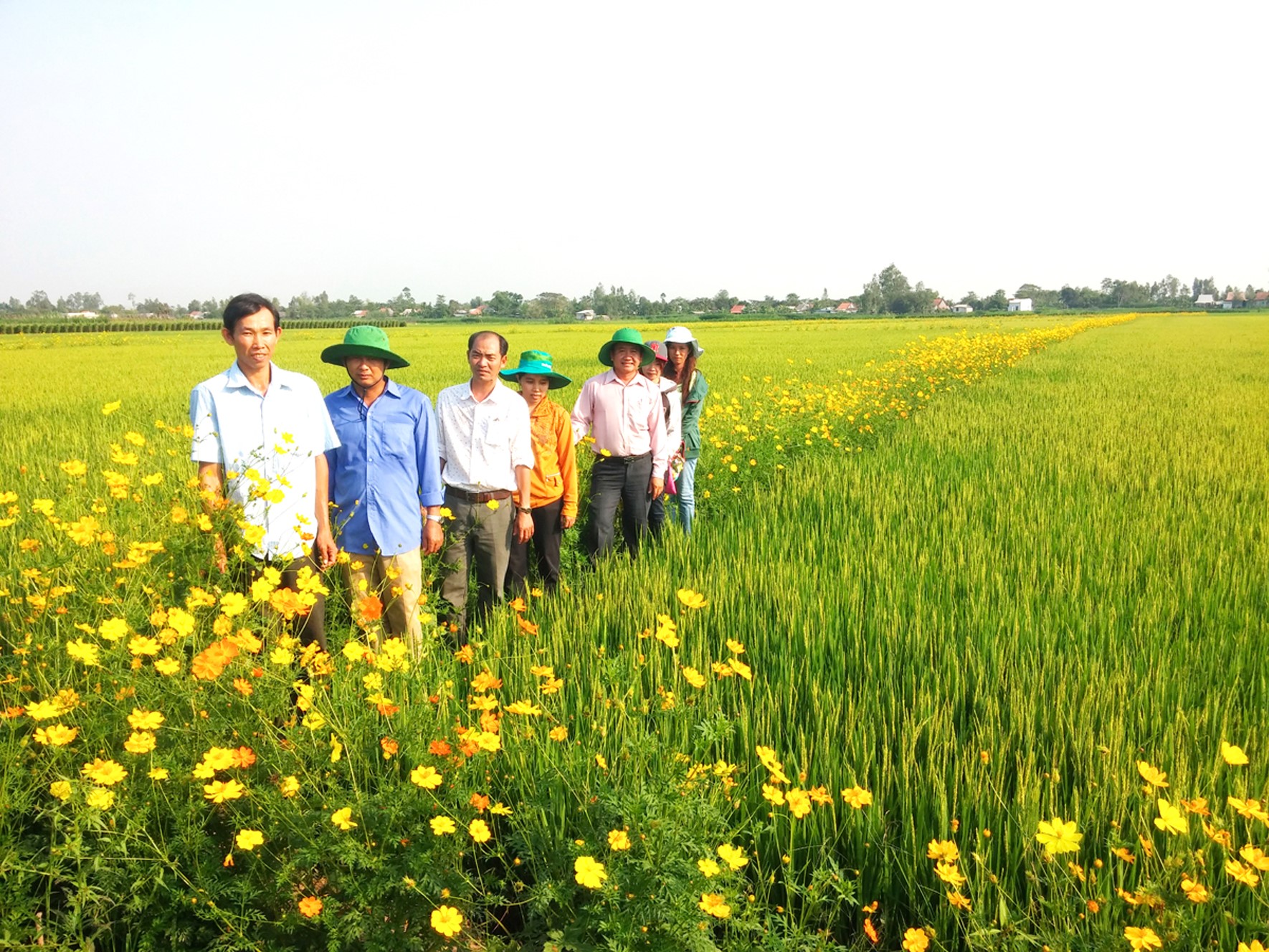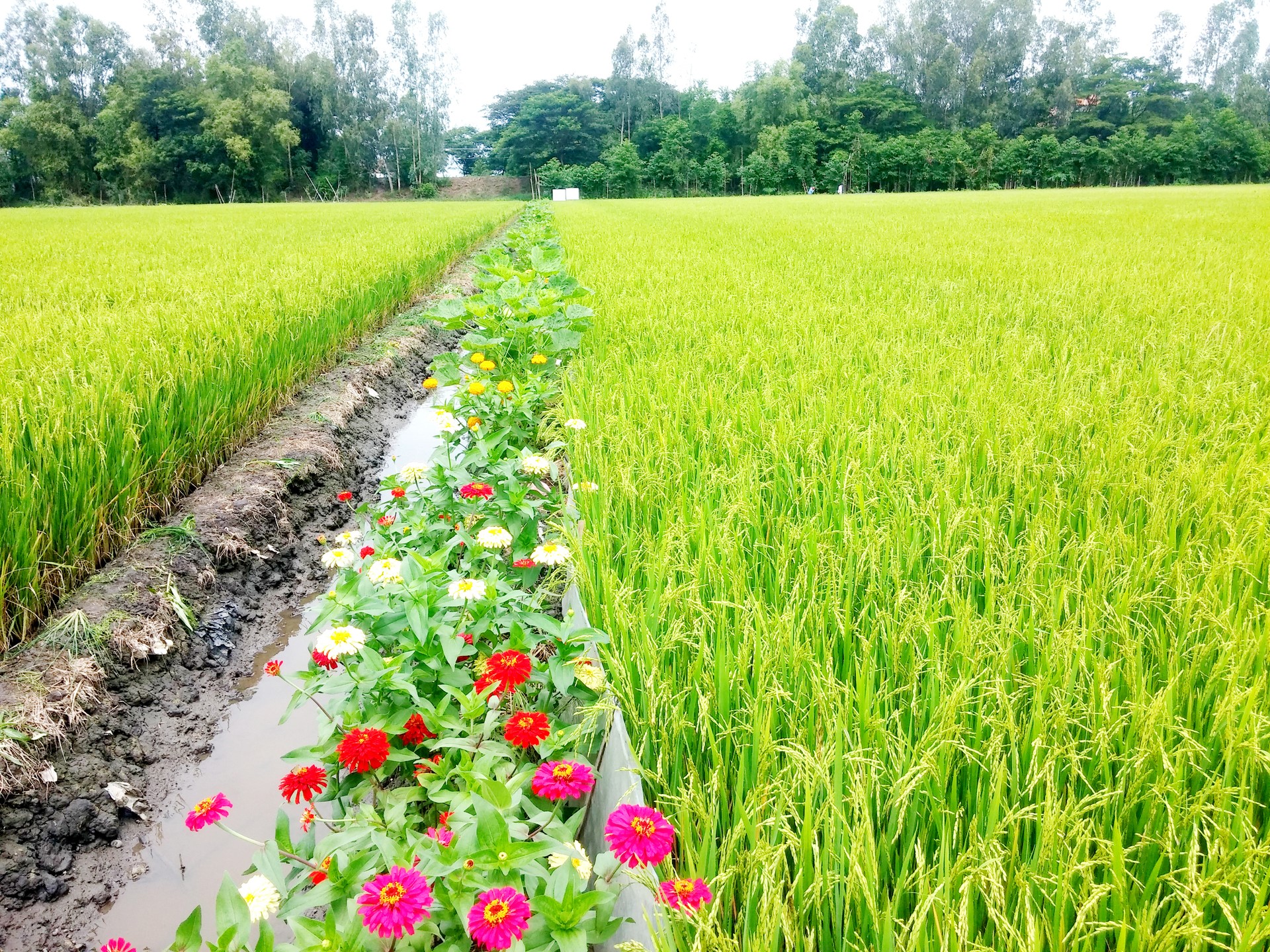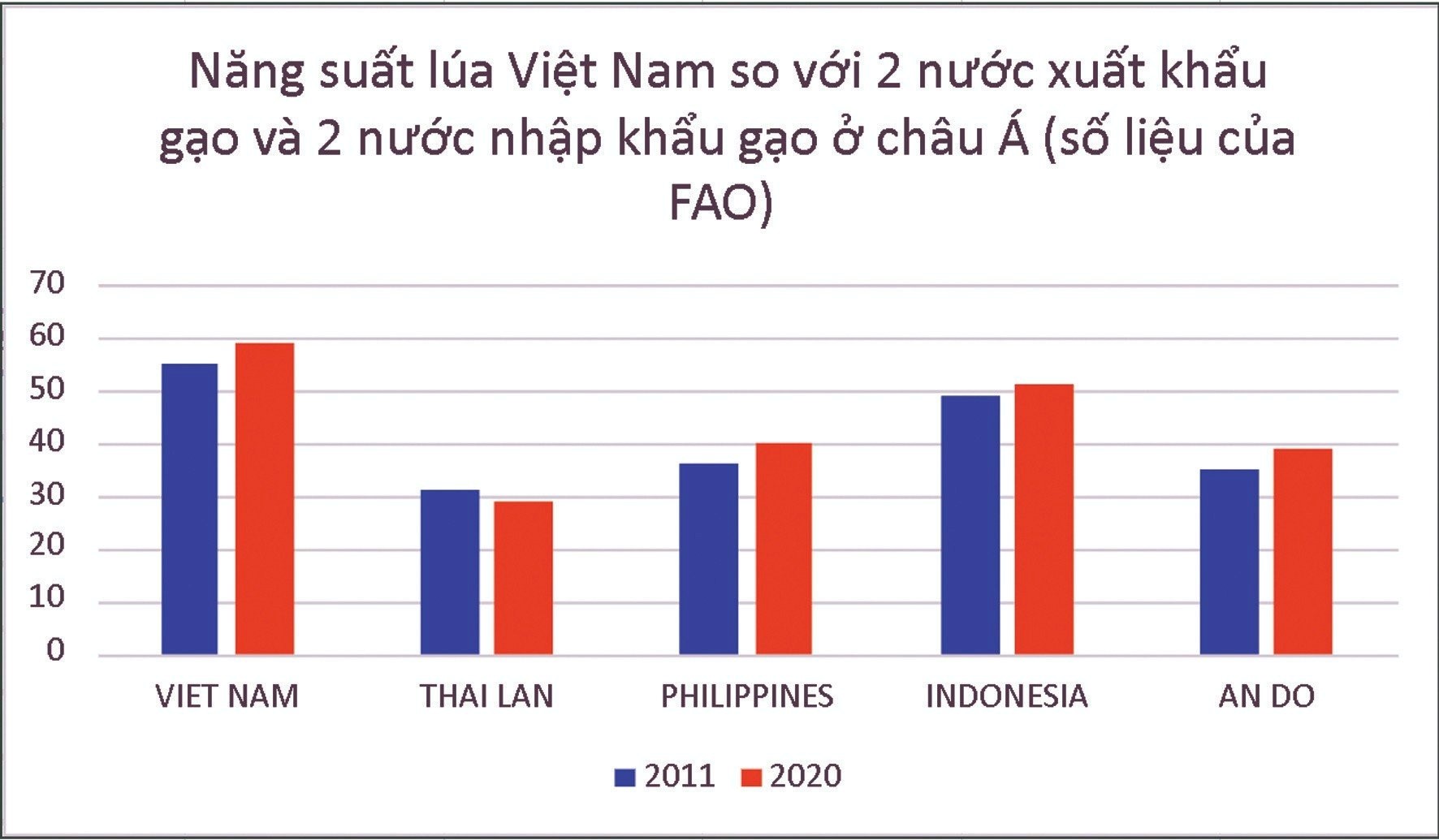May 30, 2025 | 21:32 GMT +7
May 30, 2025 | 21:32 GMT +7
Hotline: 0913.378.918
May 30, 2025 | 21:32 GMT +7
Hotline: 0913.378.918

During the 2020–2022 period, the Party and State have had direct strategic directions for the development of the rice industry until 2030, including:
- Stabilize 3.5 million hectares of rice land and ensure an annual rice output of at least 35 million tons, serving as the core to ensure national food security (Conclusion No. 81-KL/TW dated July 29, 2020 of the Political Bureau; Resolution No. 39/2021/QH15 dated November 13, 2021 of the National Assembly).
- Innovate policies on managing and using rice land towards flexibility and efficiency; promote the application of advanced technology and production processes; promote accumulation, concentration, and flexible and effective use of rice land (Resolution No. 19-NQ/TW dated June 16, 2022, Fifth Plenum of 13th CPV Central Committee).
It can be said that rice is a very special industry in agriculture due to receiving direct directions from the Party and State. The strategic directions serve as the foundation for the long-term and sustainable development of the rice industry.

Model of rice fields with flower banks in the Mekong Delta
According to the Ministry of Natural Resources and Environment, the whole country's rice land area in 2020 reached 3.9 million hectares, which is distributed according to eco-regions: Mekong Delta (1.8 million hectares), Red River Delta (560,000 hectares), Northern Midlands and Mountainous (580,000 hectares), North Central and Central Coast (700,000 hectares), Southeast (120,000 hectares), and Central Highlands (185,000 hectares). Of which, the Mekong Delta accounts for 46% of the country’s rice land area.
From 2011 to 2020, the rice land area decreased by about 200,000 hectares, in which the Mekong Delta decreased by about 130,000 hectares in the period after 2018. The country's rice cultivation area in 2020 reached 7.2 million hectares, a decrease of 400,000 hectares over 2011 and 600,000 hectares over 2015. The cultivated area decreased mainly in the Red River Delta, while that of the Mekong Delta was around 4.0 million hectares with little fluctuation.
Some records on rice land fund transformation are as follows:
- The Mekong Delta is a key rice production region in the country at present and in the future. Therefore, the transformation of rice land needs to achieve multiple goals, including increasing income for farmers, contributing to national food security, and aiming to export. From this perspective, it can be seen that the project “Sustainable development of 1 million hectares of high-quality rice in the Mekong Delta by 2030” that the Prime Minister assigned the Ministry of Agriculture and Rural Development to develop for approval is very urgent.
- Regarding the trend of rice land transformation in regions outside the Mekong Delta in recent times, there have been few major changes in the cultivated area. As a result, rice output has not decreased but even increased in some places, such as the Central Highlands. This is a positive trend consistent with the approach of ensuring in-place food security (except for the Southeast region, including Ho Chi Minh City). These regions still have small fertile plains with a yield of 5.5–over 6.0 tons/ha, except for some provinces in the Northern Midlands and Mountainous, with a yield of 4-5 tons/ha. Localities with low rice yields need investment and support in agricultural extension to ensure at least their in-place food security and increase income through the production of local specialty rice and organic rice combined with eco-tourism, as many models are being implemented in many places.
- It will be more flexible in arranging production systems on rice land if "rice land" is understood in the sense of land that is ecologically suitable for growing rice. Thereby, areas specializing in rice cultivation do not necessarily have to grow two rice crops but can grow one rice crop rotated with seafood and vegetables. A flexible production system on rice land helps increase production diversity and meet fluctuating rice market requirements while still preserving rice land.
- The transformation of rice land for other agricultural purposes needs to ensure minimum concentration to avoid fragmented transformation, breaking the concentration of rice areas, or creating conflicts between different production goals.
- In order to encourage regions and localities with ecological advantages and conditions for commodity rice production to maintain the rice land fund for a long time, the State needs to have investment policies on infrastructure for rice production and trade for the region; support localities, farmers, businesses, and cooperatives to have conditions for effective rice economic development.
- Maintaining rice land needs to be combined with improving soil quality through solutions to prevent soil degradation and improve fertility so that the area of rice land decreases but is compensated by an increase in soil productivity and a decrease in the amount of chemical fertilizer.

Flower bank-rice field is one of the models of integrated pest management that are easy to implement, cost-effective, and effective.
As mentioned above, promoting the "accumulation and concentration" of rice land is a major guideline because it will lead to a change in the face of Vietnam's rice industry, including a change in the structure and scale of rice-producing households and impacts on increasing rice production efficiency and rice growers' income.
The accumulation and concentration of rice land has been happening for many years, with many successful models across the country. However, the progress has been slow, perhaps due to insufficient legal frameworks and policies, or fears that the accumulation and concentration of land will lead to the appearance of a "new class of landlords" or take away the livelihoods of small-scale production farmers.
In fact, in Vietnam, the accumulation of rice land or agricultural land in general is difficult to happen on a large scale and form a large field. In the Mekong Delta, rice land accumulation is usually less than 10 hectares, while in the Red River Delta, many models concentrate rice land up to several hundred hectares.
The process of rice land accumulation will help increase the scale of rice-growing households, reduce the proportion of small-scale households, and increase the proportion of households with a scale suitable for each eco-region. For example, in the Mekong Delta, the accumulation process will increase the proportion of households with a scale of 2–5 hectares and decrease the proportion of households with a size of less than 1.5 ha. Increasing the scale of rice-producing households leads to a decrease in the number of rice farmers and creates conditions for raising the farmers’ position, forming a new class of farmers towards intellectualization and rejuvenation.
Over the past time, Vietnam has achieved scientific and technological achievements that have contributed to bringing the rice industry to an advanced position in the region. Vietnam's rice yield is leading in ASEAN, and the quality of Vietnamese rice has improved, making it competitive in the world market. Research and technology transfer activities for the rice industry need to continue to be renewed and improved with better resources from the investment attention of the State and businesses.

Unit: Quintal/hectare.
Two technological fields in which the rice industry has favorable conditions to achieve a pioneering position in agriculture include mechanization and automation and digital technology. Integrating these two fields contributes to creating a rice industry at a different technological level.
Regarding mechanization, as of now, the rice industry has achieved a fairly high level of mechanization and has conditions to move towards synchronous mechanization that are difficult to achieve in other farming industries. Therefore, it is necessary to promote the application of mechanization to rice production at the possibly highest level in all regions with appropriate equipment and in regions with conditions to form large fields towards synchronous mechanization. In the Mekong Delta, there is currently a gap in mechanization in the sowing and care stages. Recently, successful models of mechanization and automation of these two stages have appeared, so it is necessary to promote widespread application to achieve synchronous mechanization in rice production by 2030.
Models with the application of digital technology being deployed in rice production are showing rapid spread, such as drones, smart water level sensor systems, automatic irrigation and water withdrawal equipment remotely controlled by phone, a sensor system to monitor salinity, satellite images to monitor production developments, etc. Thereby, it is seen that the rice industry has the potential to pioneer the application of digital technology in production and the entire value chain. In the near future, rice production will be the first industry in farming to apply precision farming techniques using digital technology. Applying digital technology also helps form a new way of doing business in rice production and trading that is efficient, transparent, saves resources, and reduces greenhouse gas emissions.
Based on the above-mentioned Central's direct directions to the rice industry, it can be seen that rice land resources, rice land management and use policies, and the application of advanced technology and production processes are the foundation for the sustainable development of the rice industry. That guiding spirit needs to be realized through key actions of the agriculture sector from central to local levels to trigger changes in the rice industry in the coming time, especially when groundbreaking projects and programs related to the development of the rice industry are approved for implementation.
Translated by Huyen Vu Thu

(VAN) Several scientists and farmers are experimenting with soil treatment in some key durian-growing regions such as Cai Lay (Tien Giang), Dak Song, Gia Nghia, and Dak R’lap (Dak Nong).
/2025/05/25/4127-3-073637_820.jpg)
(VAN) Thanks to the promotion from an FAO-implemented project, vegetable production in greenhouses in Moc Chau has seen strong development, from 1.5 hectares in 2021 to nearly 50 hectares in 2024.

(VAN) FAO has recently supported USD 140,000 to implement the project 'Risk mitigation human-animal interface risks through disease control initiatives in pig farming.'

(VAN) The People's Committee of Tra Vinh province has approved an adjustment to the investment policy for the Green Hydrogen Plant project, increasing its area to approximately 52.76 hectares.
![Reducing emissions from rice fields: [2] Farmers’ commitment to the soil](https://t.ex-cdn.com/nongnghiepmoitruong.vn/608w/files/news/2025/05/05/dsc08881jpg-nongnghiep-140632.jpg)
(VAN) Clean rice cultivation model in Thuong Tan commune, Bac Tan Uyen district, is assisting local residents in achieving sustainable agriculture by substantially reducing costs, increasing productivity, and protecting the environment.

(VAN) At the conference to disseminate Resolution No. 68, AgriS introduced its digital agricultural ecosystem and reaffirmed its commitment to accompanying the Government in promoting private sector development and sustainable agriculture.

(VAN) 'Blue Ocean - Blue Foods' initiative is designed to restore marine ecosystems and establish sustainable livelihoods for local communities by cultivating a minimum of 1,000 hectares of cottonii seaweed in the first three years.